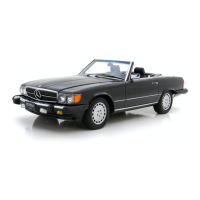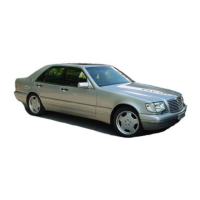
Do you have a question about the Mercedes-Benz 560 SEC 1988 and is the answer not in the manual?
| Brand | Mercedes-Benz |
|---|---|
| Model | 560 SEC 1988 |
| Category | Automobile |
| Language | English |
Information on necessary maintenance work and the maintenance booklet.
Guidelines for driving and engine speeds during the vehicle's initial break-in period.
Explanation of each gauge, indicator lamp, and knob on the instrument cluster.
Descriptions of various indicator lamps and their corresponding functions or warnings.
Important safety and operating notes to prevent damage to the catalytic converters.
Instructions for starting the engine in cold and hot conditions, including important notes.
Details on power assistance, brake pedal usage, and maintenance for the brake system.
Information on tread wear, traction, tire pressure, and aquaplaning.
Scheduled maintenance tasks based on mileage and time intervals.
Recommendations for specific maintenance items like brake fluid and coolant.
Description of the temperature selector, fan control buttons, and air outlets.
Description of master, valet, and flat keys and their respective functions.
How to lock/unlock all doors, trunk, and fuel flap simultaneously.
Description of switches for seat cushion, seatback, and head restraint adjustment.
How seat belts and ETRs function, including readiness and warning systems.
Correct method for fastening seat belts, including positioning and latching.
Important warnings and precautions regarding seat belt and air bag usage and safety.
How the driver air bag works, its monitoring by the SRS system, and indicator lamp behavior.
Notes on when the air bag activates, its effects, and the importance of wearing seat belts.
Warnings and guidelines for seat belts, ETRs, and air bag components.
Warnings about improper work on the SRS system and mandatory safety instructions.
Recommendations and legal requirements for using child restraint systems.
How the steering lock engages and disengages, and important warnings.
Explanation of the exterior lamp switch positions for parking, headlamps, and fog lamps.
Operation of turn signals, low/high beams, and high beam flasher.
Description of pushbuttons for power, volume, balance, tone, AM/FM selection, and digital display.
Detailed explanation of each selector lever position (P, R, N, D, 3, 2, B) and their functions.
Meaning of exterior light failure and fuel reserve warning lamps.
Explanation of the coolant temperature gauge and low coolant level indicator lamp.
Meaning of the brake pad wear and brake warning lamps.
How ABS prevents wheel lock-up, its indicator lamp, and malfunction indications.
How engine systems control exhaust gases and the importance of maintenance.
How to check the coolant level visually in the transparent reservoir.
Instructions for adding coolant, including mixture ratios and safety precautions.
Best time to check oil, procedure, and adding oil if needed.
Procedure for checking fluid level with engine idling, parking brake engaged, and on level ground.
Step-by-step instructions for safely changing a vehicle wheel.
Information on tire pressure differences, temperature effects, and checking pressure.
How to check electrolyte level, refill with water, and charge the battery.
Important warnings about battery fluid, hydrogen gas, and terminal clamps.
Location of the fuse box, how to exchange fuses, and warnings.
Instructions for tow-starting the vehicle, including safety precautions.
Recommended methods for towing the vehicle, including flat bed equipment.
Step-by-step instructions for jump starting a vehicle with jumper cables.
Important safety warnings and precautions when jump starting a battery.
Warning about the importance of properly positioned head restraints for accident protection.
Diagram showing the location of certification, identification, and emission control tags.
Details on engine type, displacement, compression ratio, output, and torque.
Details on engine type, displacement, compression ratio, output, and torque.
Engine oil capacity with filter change and recommended oil grades.
Initial fill and fluid change capacities for the automatic transmission.
Specific engine oils recommended for suitability and availability.
Guidelines for using premium unleaded gasoline, including octane rating and additives.
Importance of brake fluid boiling point, replacement schedule, and approved types.
Details on coolant mixture for freeze/corrosion protection and recommended types.
Recommended coolant mixture ratios for freeze protection and importance of checking concentration.
Figure showing braking performance under different conditions and partial brake system failures.
General safety warnings about performing maintenance or repairs on the vehicle.











